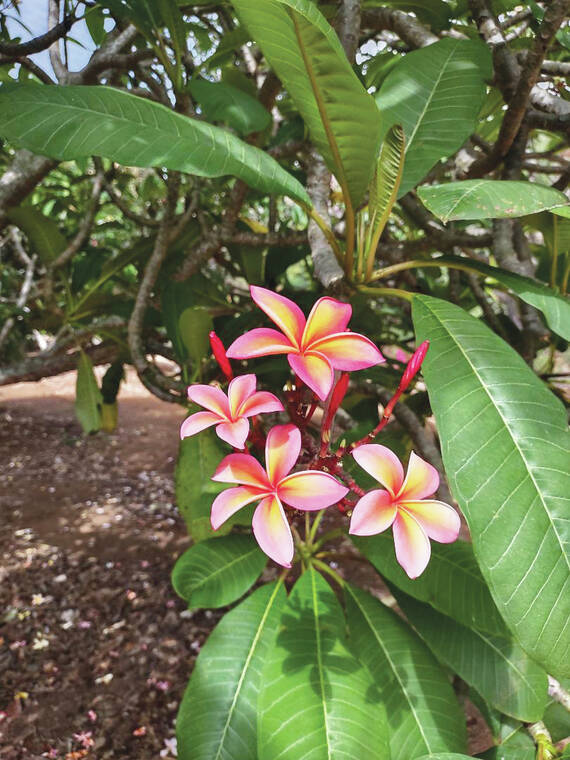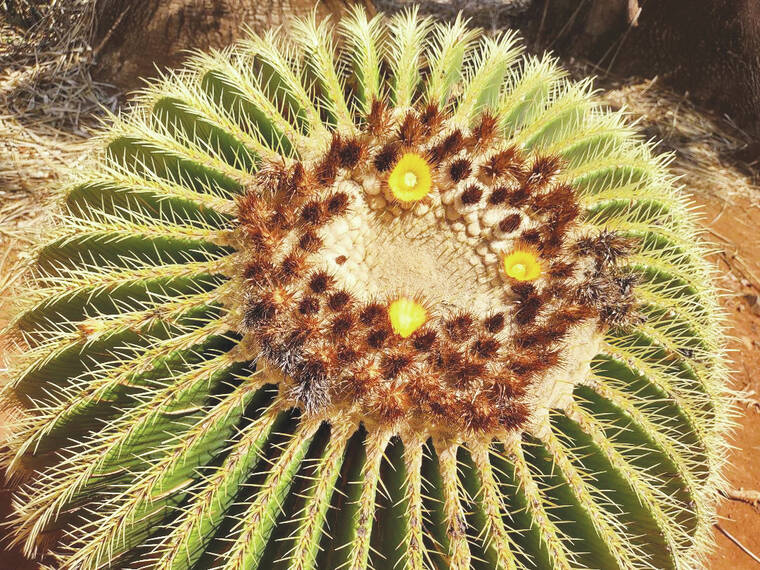Lots of folks are travelling this summer. If you are thinking of getting out of town, consider a short and relatively inexpensive jaunt to Honolulu. Low inter island fares and reasonable kama’aina rates might make a short trip affordable. There is lots to see in the city and fun to be had at the beach. Plant lovers may want to explore one or more of the Botanical Gardens in and around Honolulu during your visit.
One of my favorites is the Botanical Garden that is nestled in the 200-acre crater inside Koko Head volcano (now extinct). More than sixty acres of the basin is currently planted with collections of dryland plants. Since we are always looking for drought tolerant plants for our gardens, this is a great place to get ideas for new plants.
The space for the botanical garden was set aside in 1958 and on my last visit, they were still installing new species. The garden is divided into seven sections representing different geographic areas and particular species.
You can enter through the free parking lot and pick up a brochure to guide you through the property. As you enter the garden proper you will be assaulted by the fragrance from numerous plumeria trees. Many different species are represented with a variety of floral colors, shapes and scents. Look for ‘Angus Gold’ and ‘Cerise’ for some heady fragrances and intense coloration.
Along the entrance path, you’ll also see lots of large ranging bougainvillea shrubs climbing up the walls in a cacophony of color. Though the brochure suggests going to the left at the upcoming fork where the long loop begins, I usually go to the right since I am anxious to check on the hibiscus hybrids and the cacti.
I am always delighted by the variegated hibiscus species and enjoyed seeing some varieties that were new to me. The Pacifica collection is next, including plants native to Polynesia and some native Hawaiian plants that might be familiar to you like beach naupaka as well as the large hala (Pandanus) and milo trees.
One of my favorite sections is the Americas collection. My last visit was in early July and the ‘Swan’s neck’ agave had just finished blooming. The ‘Golden Barrel’ cactus was starting to bloom and the ‘Giant Yucca’ was in full, lustrous bloom.
I always like to fully explore the Hawaiian section. You’ll find a collection of the native loulu fan palms as well as a wiliwili grove before you turn down into the expanded section. It’s filled with many dryland specimens that you might want to consider for your garden. The small ‘a’ali’i tree and the larger alahe’e are represented as well as the prickly poppy, pua kala. You’ll find the state flower, ma’o hau hele as well as the Hawaiian cotton, ma’o. Several healthy specimens of the drought tolerant kului also grace this section. Don’t forget to smell the pretty white hibiscus with the magenta stamen known as kokio ke’o ke’o.
Next on the loop is a visit to the flora of Madagascar. The sprawling Ficus vasta lives up to its name with a wide spreading tangle of branches, roots and aerial roots. A little further along the path you’ll see the henna shrub, native to parts of Africa as well as the middle east. The leaves from this plant make the famous brown dye used in many cultures for tattoos. Of course, the huge baobabs are always an attention-grabber. Their swollen trucks enable them to hold water for the long dry spells in their native Africa.
Another African native is the sausage tree. No blooms or sausages were visible this visit, but both make this an interesting specimen to add to a landscape. The Transvaal gardenia was another curious species. The fragrant white flower of this gardenia was not in bloom but numerous seed pods were present on the small tree. About three inches across, they are grey- green with ridges like a pumpkin. Another of the many distinctive species from the African continent.
The last stop for me was the Dryland Palms section. Always a stunner, the Mexican blue fan palm remains one of my favorites.
Walking the entire two-mile garden loop takes less than two hours allowing time to stop and look, read the signs and snap some photos.
Just so you know, you can get to the garden by bus as long as you are willing to walk a bit from the bus stop to the garden entrance. Check the schedule for one that goes closest to the garden.
The garden is free and open to the public daily from sunrise to sunset. Be sure to check the website before you go, however, as they occasionally close for inclement weather or periodic maintenance.
If you just can’t make it to Oahu this summer, do check out the Garden’s website for lots more information, photos and a virtual tour. Simply enter Koko Crater Botanical Garden in your web browser and open their site or go directly to https://www.honolulu.gov/parks/hbg/honolulu-botanical-gardens/182-site-dpr-cat/572-koko-crater-botanical-garden.html.
I hope you find time to check out their site on the web or to enjoy an Oahu mini-vacation and see some wonderful plant specimens live at the Koko Crater Botanical Garden.
Gardening Events
Saturdays:
•“Work Day at Amy Greenwell Garden” from 9 a.m. to 12:30 p.m. Meet at the Garden Visitor Center across from the Manago Hotel in Captain Cook. Come with a mask and prepared to practice social distancing. Volunteers can help with garden maintenance and are invited to bring a brown bag lunch. Water and snacks provided. Visit the website www.amygreenwell.garden/get-involved/volunteer-1/ and sign up for the weekly email for more information on work days.
Thursday, July 20:
•“Nutrien Ag Solutions 2023 Educational Seminar” from 8 a.m. to 3:30 p.m. at the Hilo Hawaiian Hotel. $45 fee includes refreshments, lunch and light pupu session at 6 p.m. Register by Monday, July 10. Contact Ken Ogawa at 808-960-3802 or Aaron Pruett at 808-209-6350 or e mail them at ken.ogawa@nutrien.com or aaron.pruett@nutrien.com for more information. Tuesday, July 25:
•“Pesticide Disposal Program” from 9 to 10 a.m. on Zoom. A series providing information on acceptable pesticide disposal methods. Sponsored by HDOA. Contact Adam Williams at 808-973-9408 or adam.williams@hawaii.gov for more information. Link to the zoom meeting is: https://us02web.zoom.us/j/82676848354.
Tuesday &Wednesday, August 9 &10:
•“Invasive Pest Conference at the Blaisdell Center in Honolulu. Presentations on invasive pests by UH faculty and associates. Keynote Speaker: Philip Andreozzi, USDA invasive species coordinator. Contact roshanm@hawaii.edu for more information or register at Eventbrite: https://www.eventbrite.com/e/667750087487.
Farmer Direct Markets
(Check websites for the latest hours and online markets) Wednesday:
•“Ho’oulu Farmers Market” 9 a.m. to 2 p.m. at Sheraton Kona Resort &Spa at Keauhou Bay
Saturday:
•“Keauhou Farmers Market” 8 a.m. to noon at Keauhou Shopping Center Information on their online market: keauhoufarmersmarket.com/onlinemarket
•“Kamuela Farmer’s Market” 7:30 a.m. to noon at Pukalani Stables
•“Waimea Town Market” 7:30 a.m. to noon at the Parker School in central Waimea
•“Waimea Homestead Farmers Market” from 7:30 a.m. to noon at the Waimea middle and elementary school playground
Sunday:
•“Pure Kona Green Market” 9 a.m. – 2 p.m. at Amy Greenwell Garden in Captain Cook
•“Hamakua Harvest” 9 a.m. to 2 p.m. at Hwy 19 and Mamane Street in Honoka’a
Plant Advice Lines
Anytime: konamg@hawaii.edu
Tuesdays &Thursdays: 9 a.m. to noon at UH-CES in Kainaliu – 322-4893 or walk in
Mon., Tues. &Fri: 9 a.m. to noon at UH CES at Komohana in Hilo 981-5199 or himga@hawaii.edu
Diana Duff is a plant adviser, educator and consultant living part time in Kailua-Kona.


